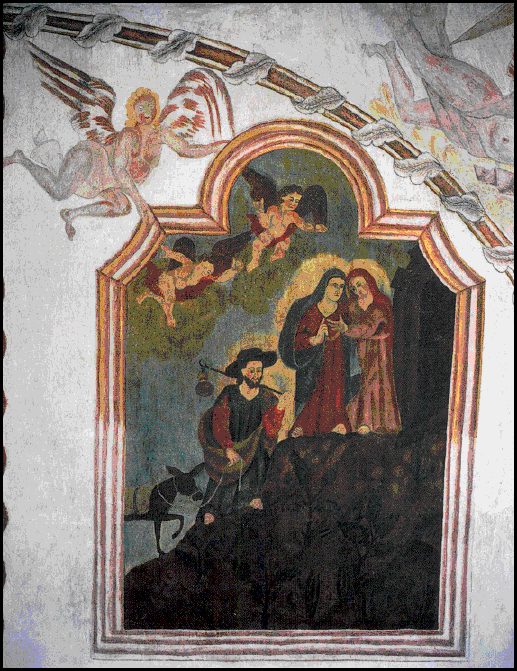
A Gift of Angels
The Art of Mission San Xavier del Bac
Bernard L. Fontana
Edward McCain, Photographer
(University of Arizona Press)

Mission San Xavier was one of twenty-five missions cooked up at the end of the 17th Century in present-day Arizona and northern Mexico by the indefatigable Father Eusebio Kino. "Cooked up" may be the correct phrase, because it lives in the Sonoran Desert, one of the hottest spots on earth, comparing favorably with the Atacama in Chile, the Patagonian in South America, or the Kalahari Desert in Africa. Wikipedia warns us not to confuse "desert" with "dessert" so we won't.Mission San Xavier was first constructed of mud and cow manure in 1756, and we are wondering if it was allowed to melt away in the winter rainstorms that sweep this region because it smelled so bad, especially when wet. However, the larger mission appeared in its final (and less noisome) form more or less complete at the end of the 18th Century.
It was designed to care for the spiritual needs of the O'odham Indians, since Spanish Catholic missionaries were convinced that all Indians were heathens and needed special spiritual guidance and huge churches so they could get into heaven. We have no record of what the O'odham --- a very tolerant people --- thought of the mission, although it is said that when the Jesuits were kicked out by Charles III, the O'odham kept the church from falling apart entirely.
According to the author, Mission San Xavier is what they call a "cruciform" church in the Reformation Baroque style. The present edifice rises like a ghost out of the desert nine miles south of that ghastly Tucson, Arizona. It --- the Mission, not Tucson --- is peopled with 53 statues of saints, 171 angels, hordes of pilgrims ... and two golden smiling lions.
The entryway features snakes for door handles, along with furtive cats and mice. If anything, the designers had a sly wit, and the whole is, as Fontana suggests, a "joyous" edifice. In fact, some of the angels come complete with fiddles, holding up the squinches. The angels are so charming that you want to slip them in your back-pocket and take them home with you. One nut-case did just that: he was so charmed by the original smiling lions that he stole them, took them home and set them on fire. The present ones were conceived and built two decades ago by a company that specializes in carrousels.
And that word "squinches." I didn't make it up, although I wish I had. It refers to the corners that hold up the dome as conceived by the builder, a "maestro albañil" by the name of Ignacio Gaona. He and his craftsmen, mostly Pima Indians, thought up all those angels, rats, cats, and lions and the statues of the saints.
This volume, The Art of Mission San Xavier del Bac is not only heavy on detail, it is heavy, weighing in on my scale at 350 pages and several tons. That's O.K. by me, though: A Gift of Angels is crawling with facts and figures and more than 175 photographs --- and is gorgeous to boot.
Each part of the Church --- from Façade to Nave, Drum and Crossing, is described in minute detail, each detail drawing on such obscure facts as the history of Spanish Church architecture in the Americas, the original colors, and how the pigments were fabricated: "red ocher, yellow ocher, burnt ocher, carbon black and copper resonate." (The blue is called "smalt," which now is another of my favorite words from this book, along with "narthex," "pendentive," and "squinch.")
The author knows his stuff. As an example, take the particulars of the Visitation which is pictured on two of the walls in San Xavier. In 1670, a nun, Mother María Jesús de Agreda, wrote her version of it in a book Mística Ciudad de Dios, inspired, it is said, by direct communication by the divine. Pope Innocent XI, in keeping with the sourpuss tradition of all Popes named Innocent --- viz, the Crusades --- condemned innocent María's version of heavenly conjoining ... and she was forced to burn all her writings on the subject, if not herself.
It was too late, The Mystical City of God became the Danielle Steele hit of the 17th Century, and the good mother nun's take on the Visitation inspired the artists at San Xavier del Bac to paint a scene of Joseph appearing with a fedora on head and a run-away-from-home stick-&-sack on his back --- along with Mary, their Cousin Elizabeth, two plump angels, a merry burro and a sagaro cactus ... as befits a hot Visitation in the hot Sonoran Desert. The whole is supported by a bediapered angel hovering there in the sanctuary, smiling at us all at his or her sacred mission to keep the Visitation floating merrily before our very eyes, perhaps forever.

--- Carlos Amantea